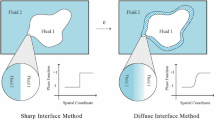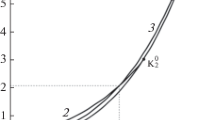Abstract.
We make the connection between the geometric model for capillarity with line tension and the Cahn‐Hilliard model of two‐phase fluids. To this aim we consider the energies\(F_\eps(u):=\eps\int_\O |Du|^2 + {1\over\eps} \int_\O W(u) + \lambda\int_{\bd\O} V(u)\) where u is a scalar density function and W and V are double‐well potentials. We show that the behaviour of F ε in the limit ε→0 and λ→∞ depends on the limit of ε log λ. If this limit is finite and strictly positive, then the singular limit of the energies F ε leads to a coupled problem of bulk and surface phase transitions, and under certain assumptions agrees with the relaxation of the capillary energy with line tension. These results were announced in [ABS1] and [ABS2].
Similar content being viewed by others
Author information
Authors and Affiliations
Additional information
(Accepted November 5, 1997)
Rights and permissions
About this article
Cite this article
Alberti, G., Bouchitté, G. & Seppecher, P. Phase Transition with the Line‐Tension Effect. Arch Rational Mech Anal 144, 1–46 (1998). https://doi.org/10.1007/s002050050111
Issue Date:
DOI: https://doi.org/10.1007/s002050050111




